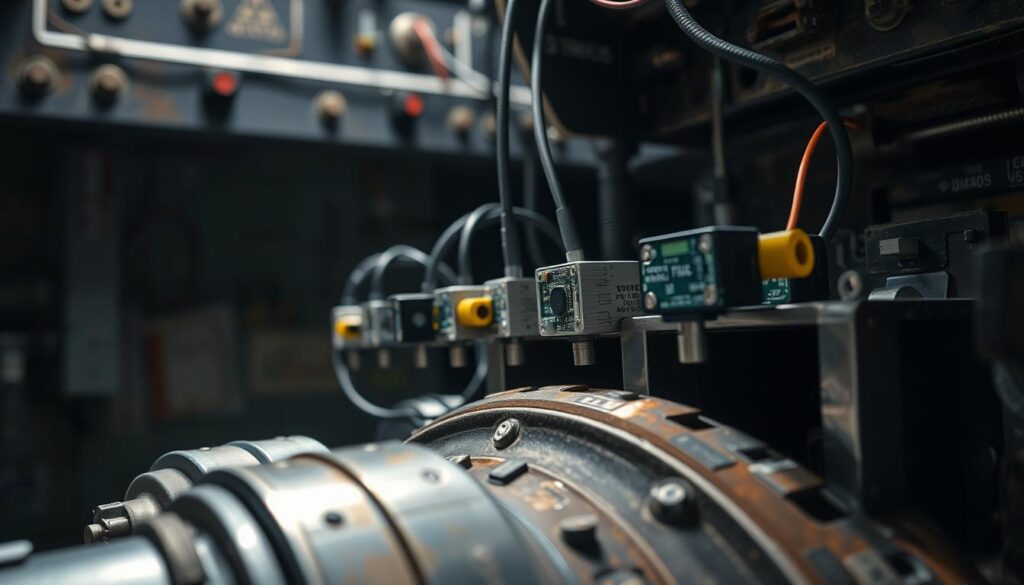Germany is prone to seismic activities, making earthquake prevention systems crucial for ensuring structural integrity and safety. The use of vibration monitoring technology has become increasingly important in detecting seismic events and mitigating potential damage.
The implementation of advanced vibration sensors has revolutionized the field of earthquake prevention. These sensors enable early detection of seismic events, allowing for prompt action to be taken to minimize damage.
Key Takeaways
- Advanced vibration sensors play a crucial role in earthquake prevention.
- Germany’s seismic activity necessitates effective earthquake prevention systems.
- Vibration monitoring technology is essential for detecting seismic events.
- Early detection enables prompt action to minimize damage.
- Seismic detection solutions are vital for ensuring structural integrity.
Introduction to Earthquake Prevention Technologies
Germany’s geographical location makes it susceptible to earthquakes, highlighting the need for advanced earthquake prevention technologies. The country’s seismic activity, although not as frequent as in some other parts of the world, can still have significant impacts on infrastructure and communities.
Overview of Earthquake Risks in Germany
Germany is located in a region of moderate seismic activity. While major earthquakes are rare, the country has experienced significant seismic events in the past, such as the 1992 Roermond earthquake in the Netherlands, which was felt in parts of Germany. The risk is particularly relevant in regions near tectonic plate boundaries.
The consequences of earthquakes can be severe, including damage to buildings, infrastructure disruption, and potential loss of life. Therefore, understanding and mitigating these risks is crucial for public safety and economic stability.
Importance of Advanced Vibration Sensors
Advanced vibration sensors play a critical role in earthquake prevention and mitigation. These sensors can detect the slightest vibrations in the ground, providing early warnings that can be crucial in saving lives and reducing damage to infrastructure.
The technology behind these sensors involves sophisticated mechanisms that can differentiate between various types of vibrations, ensuring that alerts are sent out only when necessary. This specificity is vital in preventing unnecessary evacuations and ensuring that responses are proportionate to the threat.
How Technology Can Mitigate Risks
Technology, particularly advanced vibration sensors and earthquake-resistant infrastructure, can significantly mitigate the risks associated with earthquakes. By integrating these technologies into urban planning and infrastructure development, Germany can enhance its resilience to seismic events.
For instance, the use of augmented vibration sensing devices can provide real-time data on seismic activity, enabling more effective emergency response planning. Moreover, the incorporation of earthquake-resistant design principles in construction can minimize damage to buildings and infrastructure.
| Technology | Function | Benefit |
|---|---|---|
| Advanced Vibration Sensors | Detect ground vibrations | Early warning systems for earthquakes |
| Earthquake-Resistant Infrastructure | Withstand seismic forces | Reduced damage to buildings and infrastructure |
| Augmented Vibration Sensing Devices | Provide real-time seismic data | Enhanced emergency response planning |
Understanding Advanced Vibration Sensors
The integration of cutting-edge seismic sensors into earthquake prevention systems marks a significant advancement in safeguarding structures and lives. These sensors are pivotal in detecting seismic activity, thereby playing a crucial role in mitigating the impact of earthquakes.
Definition and Functionality
Advanced Vibration Sensors are sophisticated devices designed to detect and measure vibrations in structures, such as buildings and bridges. These sensors can identify the slightest movements, providing critical data on seismic activity. They operate on various principles, including accelerometers, geophones, and velocimeters, each suited to different applications and offering unique benefits.
The functionality of these sensors is rooted in their ability to convert mechanical vibrations into electrical signals, which are then analyzed to understand the nature of the seismic event. This process enables early detection and warning systems, crucial for preventing damage and saving lives.
Key Features of Modern Sensors
Modern vibration sensors boast several key features that enhance their effectiveness in earthquake prevention. These include:
- High sensitivity to detect even minor vibrations
- Real-time data processing capabilities
- Robust design to withstand harsh environmental conditions
- Integration with early warning systems for immediate action
These features collectively contribute to the sensors’ ability to provide accurate and timely data, essential for earthquake risk mitigation.
Applications in Earthquake Prevention
The applications of advanced vibration sensors in earthquake prevention are multifaceted. They are used in:
| Application | Description | Benefit |
|---|---|---|
| Structural Health Monitoring | Continuous monitoring of structures for signs of damage or stress. | Early detection of potential issues, reducing maintenance costs. |
| Seismic Activity Detection | Identification of seismic events and measurement of their intensity. | Enables early warning systems, saving lives and reducing damage. |
| Research and Development | Data collected is used to improve understanding of seismic activity and develop new technologies. | Advancements in earthquake science and prevention technologies. |
By understanding and leveraging advanced vibration sensors, Germany can enhance its earthquake prevention capabilities, ensuring a safer environment for its citizens and infrastructure.
The Role of Vibration Sensors in Earthquake Prediction
Real-time monitoring capabilities of vibration sensors are pivotal in predicting earthquakes and mitigating their impact. These sensors are designed to detect even slight ground movements, providing crucial data for earthquake prediction.
Real-Time Monitoring Capabilities
Vibration sensors are equipped with advanced technology that enables them to monitor seismic activity continuously. This real-time monitoring capability is essential for detecting the early signs of an earthquake, allowing for timely warnings and evacuations.
The data collected by these sensors is transmitted to central monitoring stations, where it is analyzed to predict potential earthquakes. This process involves sophisticated algorithms that can identify patterns indicative of seismic activity.
Historical Data Analysis
In addition to real-time monitoring, vibration sensors also contribute to historical data analysis. By accumulating data over time, researchers can identify trends and patterns that may not be apparent from real-time data alone.
This historical data is invaluable for understanding the seismic behavior of a region, helping to improve the accuracy of earthquake predictions. It also aids in the development of more effective early warning systems.
| Feature | Description | Benefit |
|---|---|---|
| Real-Time Data | Continuous monitoring of seismic activity | Timely earthquake warnings |
| Historical Analysis | Accumulation of seismic data over time | Improved prediction accuracy |
| Early Warning Systems | Integration with vibration sensor data | Enhanced public safety |
Integration with Early Warning Systems
The integration of vibration sensors with early warning systems is a critical aspect of earthquake preparedness. By combining real-time data with advanced algorithms, these systems can provide seconds to minutes of warning before an earthquake strikes.
This early warning can be the difference between life and death, allowing people to seek safety before the earthquake hits. It also enables automated systems to shut down critical infrastructure, reducing potential damage.
Current Technologies in Germany’s Earthquake Prevention
Germany’s approach to earthquake prevention involves cutting-edge technology and innovative solutions. The country is leveraging advanced vibration sensors and seismic detection solutions to enhance its earthquake prevention capabilities.
Notable Companies and Their Innovations
Several companies are at the forefront of Germany’s earthquake prevention technology. Riverhawk Company, Geospace Technologies Corporation, and IMV Corporation are notable manufacturers of seismic sensors. These companies are developing advanced vibration sensors that can detect even slight seismic activities, enabling early warning systems to prevent damage.
The innovations by these companies include:
- High-sensitivity seismic sensors capable of detecting minor ground movements.
- Advanced data analytics software for predicting seismic events.
- Integration of seismic sensors with existing infrastructure for real-time monitoring.
Government Initiatives and Regulations
The German government is actively involved in promoting earthquake prevention through various initiatives and regulations. These include funding research projects focused on improving seismic detection and developing early warning systems.
Some key government initiatives are:
| Initiative | Description |
|---|---|
| Seismic Research Funding | Providing financial support for research into advanced seismic detection technologies. |
| Regulatory Frameworks | Establishing standards for the integration of seismic sensors into building codes. |
| Public Awareness Campaigns | Educating the public on earthquake risks and prevention measures. |
Research and Development in Earthquake Technology
Research and development play a crucial role in advancing Germany’s earthquake prevention technologies. Ongoing R&D efforts are focused on improving the accuracy and reliability of seismic sensors, as well as developing new technologies for earthquake early warning systems.
Key areas of research include:
- Enhancing sensor sensitivity to detect low-magnitude earthquakes.
- Developing machine learning algorithms for predictive analytics.
- Improving communication networks for rapid data transmission during seismic events.
Case Studies: Successful Implementations
Vibration sensors have become a crucial tool in Germany’s earthquake prevention strategy, with case studies highlighting their effectiveness in diverse settings.
Urban Areas Utilizing Vibration Sensors
Urban areas in Germany have seen significant benefits from the implementation of vibration sensors. For instance, cities like Berlin and Munich have integrated these sensors into their infrastructure to monitor and respond to seismic activity effectively.
A notable example is the deployment of vibration sensors in the construction of new buildings and the retrofitting of existing structures in urban centers. This has enabled real-time monitoring and early warning systems, significantly reducing the risk of earthquake damage.
Rural Applications and Impact
In rural areas, vibration sensors have also proven to be invaluable. They have been used to monitor seismic activity in regions that are prone to earthquakes but lack the dense infrastructure of urban areas.
The impact in these areas has been substantial, with communities benefiting from enhanced early warning systems that provide critical seconds or minutes to evacuate or secure their surroundings.
Comparative Analysis of Sensor Effectiveness
A comparative analysis of the effectiveness of vibration sensors in urban versus rural areas reveals interesting insights.
While urban areas benefit from the dense network of sensors, rural areas have seen significant advantages from targeted deployments. The data suggests that both approaches have their merits, and the choice between them should be based on the specific seismic risk profile of the area.
“The integration of vibration sensors into our earthquake prevention strategy has been a game-changer. It has allowed us to respond more effectively to seismic events and protect our communities.” –
Challenges in Implementing Vibration Sensors
While vibration sensors offer a promising solution for earthquake early warning systems, their implementation is not without difficulties. The deployment of these advanced sensors in Germany is crucial for enhancing earthquake preparedness, but several challenges need to be addressed.

Technical Limitations and Solutions
One of the primary challenges is the technical limitations associated with vibration sensors. These include sensitivity to environmental factors such as temperature and humidity, which can affect their accuracy. Augmented vibration sensing devices are being developed to mitigate these issues. For instance, some modern sensors are designed with enhanced shielding to reduce interference.
Another technical limitation is the need for robust data processing algorithms to interpret the data collected by these sensors accurately. Advanced algorithms and machine learning techniques are being employed to improve the reliability of earthquake predictions.
Financial Considerations for Municipalities
The financial implications of implementing vibration sensors are a significant concern for municipalities. The cost of purchasing and installing these sensors, as well as maintaining and upgrading them over time, can be substantial. Municipalities must weigh these costs against the potential benefits of enhanced earthquake preparedness.
To address financial considerations, some municipalities are exploring public-private partnerships to share the costs and expertise. Additionally, government grants and subsidies are being made available to support the adoption of vibration sensor technology.
Public Awareness and Education
Public awareness and education are critical components of a successful earthquake early warning system. It is essential to educate the public on how to respond when an earthquake warning is issued. This includes conducting regular drills and providing clear instructions on evacuation procedures and safety measures.
Effective public awareness campaigns can significantly enhance the effectiveness of vibration sensor technology. By understanding the role of these sensors in earthquake prevention, the public can better appreciate the importance of their implementation.
Future Trends in Earthquake Prevention Systems
Emerging trends in Earthquake Prevention Systems are highlighting the critical role of Global Collaboration in enhancing seismic resilience. As the frequency and intensity of earthquakes continue to pose significant threats, the need for advanced, integrated solutions has never been more pressing.
Advancements in Sensor Technology
The future of Earthquake Prevention Systems is heavily reliant on advancements in Sensor Technology. Modern sensors are becoming increasingly sophisticated, capable of detecting even the slightest vibrations with greater accuracy and reliability. These advancements are crucial for early warning systems, enabling communities to take necessary precautions before an earthquake strikes.
The integration of Artificial Intelligence (AI) and Machine Learning (ML) algorithms with sensor data is further enhancing the predictive capabilities of these systems. By analyzing historical data and real-time inputs, AI-driven systems can provide more accurate and timely warnings.
Predictions for Future Earthquake Models
The development of more sophisticated earthquake models is another key trend in Earthquake Prevention Systems. These models are being designed to better predict the likelihood and potential impact of future earthquakes, taking into account a wide range of variables including geological data, historical seismic activity, and environmental factors.
Future earthquake models will likely incorporate complex simulations to predict how different earthquake scenarios could affect various regions. This will enable more effective planning and mitigation strategies, potentially saving lives and reducing damage to infrastructure.
Potential for Global Collaboration
The potential for Global Collaboration in earthquake mitigation efforts is vast. By sharing data, technologies, and best practices, countries can work together to develop more effective Earthquake Prevention Systems. This collaboration is essential for addressing the global nature of seismic risks.
International partnerships can facilitate the development of standardized protocols for earthquake monitoring and response, ensuring a more coordinated and effective global response to seismic events.
Regulatory Framework in Germany
The regulatory framework in Germany plays a crucial role in earthquake prevention and mitigation. It encompasses a wide range of standards, regulations, and guidelines aimed at minimizing the impact of earthquakes on the country’s infrastructure and population.
Overview of Earthquake Safety Standards
Germany has developed comprehensive earthquake safety standards that are integrated into its building codes and urban planning regulations. These standards are designed to ensure that buildings and critical infrastructure can withstand earthquake forces.
Key aspects of these standards include:
- Seismic design requirements for new buildings
- Retrofitting guidelines for existing structures
- Regular inspection and maintenance protocols
Roles of Local and National Agencies
Both local and national agencies are involved in implementing and enforcing earthquake safety regulations in Germany.
| Agency | Role |
|---|---|
| National Agency for Earthquake Prevention | Develops national policies and guidelines for earthquake prevention |
| Local Municipalities | Implement and enforce local building codes and regulations |
Compliance Requirements for Businesses
Businesses in Germany are required to comply with earthquake safety regulations, particularly those operating critical infrastructure or in high-risk seismic areas.
Compliance involves:
- Conducting regular risk assessments
- Implementing seismic safety measures
- Training personnel on earthquake response procedures
By adhering to these regulations, Germany aims to enhance its resilience to earthquakes and protect its citizens and infrastructure.
Integrating Vibration Sensors into Infrastructure
As Germany continues to face earthquake risks, the integration of vibration sensors into its infrastructure has become increasingly important. This integration not only enhances the safety of buildings and public structures but also plays a crucial role in mitigating the impact of seismic events.
The process involves two main strategies: retrofitting existing structures and designing new buildings with integrated vibration sensors. Both approaches are vital for creating a comprehensive earthquake early warning system.
Retrofitting Existing Structures
Retrofitting existing structures with vibration sensors is a complex task that requires careful planning and execution. It involves assessing the current state of the structure, identifying the most suitable locations for sensor installation, and ensuring that the sensors are integrated effectively into the existing infrastructure.
Key considerations for retrofitting include:
- Assessing structural integrity
- Selecting appropriate sensor technology
- Ensuring minimal disruption to occupants
Designing New Buildings with Sensors
Designing new buildings with integrated vibration sensors offers a proactive approach to earthquake safety. By incorporating sensors into the building design, architects and engineers can create structures that are not only resilient to seismic activity but also provide real-time monitoring capabilities.
Benefits of designing new buildings with sensors include:
- Enhanced seismic resilience
- Real-time monitoring and early warning systems
- Improved occupant safety
Collaboration with Engineers and Architects
Effective integration of vibration sensors into infrastructure requires close collaboration between engineers, architects, and other stakeholders. This collaboration ensures that the sensors are not only technically appropriate but also practically implemented within the structural design.
A key aspect of this collaboration is the development of structural health monitoring systems that can accurately detect and respond to seismic events.

| Integration Strategy | Key Benefits | Challenges |
|---|---|---|
| Retrofitting Existing Structures | Enhanced safety, real-time monitoring | Technical complexity, cost |
| Designing New Buildings with Sensors | Proactive earthquake safety, improved resilience | Higher upfront costs, design complexity |
The Role of Community Engagement
Earthquake preparedness in Germany is significantly bolstered by active community engagement. The success of earthquake prevention systems relies heavily on the participation and awareness of the community.
Educating Residents About Earthquake Preparedness
Educating residents is a critical component of earthquake preparedness. It involves informing the public about the risks associated with earthquakes and the measures they can take to mitigate these risks. For instance, residents can be taught how to secure heavy furniture, create emergency kits, and participate in regular drills.
Innovative vibration detection tools play a crucial role in this educational process. By understanding how these tools work and their importance in early warning systems, residents can better appreciate the technology behind earthquake preparedness.
“Education is the foundation of a resilient community. By empowering residents with knowledge, we can significantly reduce the impact of earthquakes.”
Involvement of Local Governments
Local governments are instrumental in promoting earthquake preparedness. They can initiate programs to educate the public, conduct regular safety drills, and ensure that buildings are constructed or retrofitted to withstand earthquakes.
| Role of Local Governments | Actions Taken |
|---|---|
| Public Education | Conducting workshops and seminars |
| Safety Drills | Organizing regular earthquake drills |
| Building Codes | Enforcing strict building codes |
Creating Awareness Campaigns
Awareness campaigns are vital in keeping the community informed about earthquake risks and preparedness measures. These campaigns can be conducted through various media, including social media, local newspapers, and community events.
By engaging the community and promoting awareness, Germany can enhance its earthquake preparedness and reduce the potential impact of seismic events.
Conclusion: The Path Forward for Earthquake Safety in Germany
Germany’s earthquake safety landscape is evolving with the integration of Advanced Vibration Sensors and other Technological Advances. These innovations are crucial in mitigating earthquake risks and enhancing overall Earthquake Safety.
Advancements in Earthquake Safety Measures
The use of Advanced Vibration Sensors has revolutionized earthquake prediction and early warning systems. By leveraging real-time monitoring capabilities and historical data analysis, these sensors play a vital role in safeguarding communities.
Importance of Sustained Investment
Continued Investment in earthquake safety measures is essential to ensure the long-term effectiveness of these systems. Germany must prioritize the development and implementation of cutting-edge technologies to stay ahead of earthquake risks.
Stakeholder Engagement
Enhancing Earthquake Safety in Germany requires a collaborative effort from stakeholders, including government agencies, private companies, and local communities. By working together, we can create a safer and more resilient environment for future generations.
FAQ
What are advanced vibration sensors, and how do they contribute to earthquake prevention?
Advanced vibration sensors are sophisticated devices designed to detect and measure seismic activity, providing critical data for earthquake prediction and prevention. They contribute to earthquake prevention by enabling real-time monitoring, historical data analysis, and integration with early warning systems, ultimately enhancing structural health and safety.
How do vibration sensors aid in earthquake prediction?
Vibration sensors aid in earthquake prediction by providing real-time monitoring capabilities, analyzing historical data, and integrating with early warning systems. This enables authorities to issue timely warnings, evacuate areas, and take necessary precautions to mitigate the impact of earthquakes.
What are the key features of modern vibration sensors used in earthquake prevention?
Modern vibration sensors used in earthquake prevention feature high sensitivity, accuracy, and reliability. They are designed to detect even slight seismic activity, providing critical data for earthquake prediction and prevention. Some sensors also offer advanced features like wireless connectivity, solar power, and ruggedized designs for harsh environments.
How are vibration sensors integrated into infrastructure in Germany?
Vibration sensors are integrated into infrastructure in Germany through retrofitting existing structures, designing new buildings with sensors, and collaborating with engineers and architects. This ensures that critical infrastructure, such as bridges, buildings, and power plants, are equipped with advanced seismic monitoring capabilities.
What are the challenges faced in implementing vibration sensors for earthquake prevention?
The challenges faced in implementing vibration sensors for earthquake prevention include technical limitations, financial considerations for municipalities, and the need for public awareness and education. Addressing these challenges requires collaboration between stakeholders, investment in research and development, and effective communication strategies.
What is the regulatory framework for earthquake prevention in Germany?
The regulatory framework for earthquake prevention in Germany includes earthquake safety standards, roles of local and national agencies, and compliance requirements for businesses. This framework ensures that buildings, infrastructure, and industries adhere to stringent seismic safety standards, mitigating the impact of earthquakes.
How can community engagement contribute to earthquake preparedness?
Community engagement can significantly contribute to earthquake preparedness by educating residents, involving local governments, and creating awareness campaigns. This fosters a culture of seismic awareness, enabling communities to take proactive measures to mitigate the impact of earthquakes.
What are the future trends in earthquake prevention systems?
Future trends in earthquake prevention systems include advancements in sensor technology, predictions for future earthquake models, and the potential for global collaboration. These developments will enhance the accuracy, reliability, and effectiveness of earthquake prevention systems, ultimately saving lives and reducing economic losses.
What is the significance of continued investment in earthquake safety in Germany?
Continued investment in earthquake safety in Germany is crucial for enhancing the country’s resilience to seismic activity. It enables the development of advanced technologies, improves infrastructure, and fosters a culture of seismic awareness, ultimately protecting lives, reducing economic losses, and promoting sustainable development.



